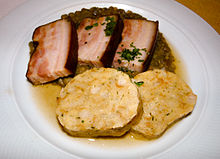Napkin dumplings

Napkin dumplings or serviette dumplings are a dish of Central European cuisine that is similar in its dough to bread dumplings , which is mainly served as a side dish , but also as a main course or dessert (mostly as a sweet pastry ).
There are many regionally very different recipes, both in terms of the method of preparation and the dough mass used, which include the entire range of dumpling doughs in terms of base mass, leavening agents and spices used.
dough
Bread dumpling dough and flour dough are used, these also with yeast as a leavening agent. Napkin dumplings are sometimes also filled, for example by rolling out the dough and shaping the dumplings from croissant triangles. According to the South Thuringian and Upper Franconian tradition, napkin dumplings are only made from bread dough.
Cooking methods
In Austria, Upper Franconia and Bohemia, it is common to wrap the dumplings in towels and boil them in water. This type of preparation is called knedlíky uvařené v ubrousku (dumplings cooked in a serviette ) or knedlíky uvařené vídenským způsobem (dumplings cooked in the Viennese style). In contrast, Bohemian dumplings are only cooked in water.
In southern German cuisine, the dough is wrapped in a napkin or other linen cloth and cooked in steam, i.e. over the boiling water. There are metal pot inserts for this purpose.
The towels used (such as swirl towels, for example ) are usually washed without the use of soap or detergents and boiled and disinfected as hot laundry or have to be flushed until no more soap foam or odor can be seen in the water or cloth.
template
After cooking and resting for a few minutes, the dumplings are cut with a thread or a knife.
Napkin dumplings are mainly served with dishes rich in sauces, such as B. with game goulash or pot roast, also with steamed fruit. The large cut surfaces bind liquids well, both sauces and vegetable water. In large kitchens, napkin dumplings made from bread dough are popular because a single large dumpling is easier to make than many small and therefore more portions can be prepared in the same time.
History and tradition
It is not known when and where the napkin dumpling was invented. Until the 1930s he was only known in Thuringia and Upper Franconia and in the area around Hamburg .
The napkin ball in the north German kitchen
In the Hamburg area, the napkin dumplings were only used by the bourgeoisie for a long time, usually only on festive occasions. Around the 1830s, the napkin dumplings found their way into the kitchen of the common people or the lower class. As a result, it became an everyday accompaniment to food, but was still valued at feasts.
The napkin ball as a wedding dish in Thuringia and Upper Franconia
At the beginning of the 18th century, the serviette dumpling established itself in southern Thuringia and Upper Franconia as an accompaniment to wedding roasts. Unlike in northern Germany , it was not used for everyday dishes. On closer inspection, it is also noticeable that there were regional differences in the importance of napkin dumplings for traditional cuisine.
In south-west Thuringia, the serving of the napkin dumplings was a new, "outstanding specialty limited to this feast [that of a wedding]", since these were otherwise deliberately not prepared for normal dishes. On the other hand, in the region from southern Vogtland to Franconian Switzerland , the napkin dumpling was already known before the 18th century and was sometimes also prepared for other feasts such as church fairs , communions, etc. The difference was even clearer in the area south of the Main . There it was served almost exclusively with sauerbraten as an accompaniment to wedding dishes, while potato dumplings were preferably served with roast pork . This also underlines the status of the napkin dumpling, as this, like the sauerbraten, is a slightly finer, better dish than the roast pork and potato dumpling.
Despite the exception of in Ostoberfranken rather strict rules when napkin dumplings were served, and when not, it is true, according to the folklorist Günter Wiegelmann certain that this type of dumplings and occasionally for other highly festive was served affairs. In the following centuries, this strict food rule was noticeably relaxed, so that today the napkin dumpling is served as a normal accompaniment to Sunday roasts in Upper Franconia and southern Thuringia . However, it is not served with all roasts, but mainly with those with a thick sauce such as veal roast , sauerbraten, etc. Ä.
See also
Individual evidence
- ↑ a b c d Mohrmann (2006), p. 88
- ↑ a b c d Wiegelmann (2006), p. 197
- ↑ a b c d Wiegelmann (2006), p. 198
literature
- Mohrmann, Ruth-Elisabeth: Eating and drinking in the modern age , Waxmann Verlag, Münster 2006, ISBN 3-8309-1701-5 , p. 88f.
- Wiegelmann, Günther: Everyday and festive dishes in Central Europe , Waxmann Verlag, Münster 2006, ISBN 3-8309-1468-7 , p. 197f.
Web links
- Dumplings in general . Entry no. 184 in the register of traditional foods of the Austrian Federal Ministry for Agriculture, Regions and Tourism .


